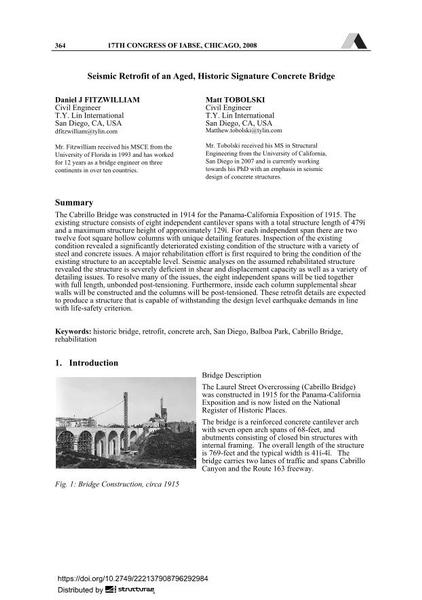Seismic Retrofit of an Aged, Historic Signature Concrete Bridge

|
|
|||||||||||
Bibliografische Angaben
| Autor(en): |
Matthew Tobolski
Daniel Fitzwilliam |
||||
|---|---|---|---|---|---|
| Medium: | Tagungsbeitrag | ||||
| Sprache(n): | Englisch | ||||
| Tagung: | 17th IABSE Congress: Creating and Renewing Urban Structures – Tall Buildings, Bridges and Infrastructure, Chicago, USA, 17-19 September 2008 | ||||
| Veröffentlicht in: | IABSE Congress Chicago 2008 | ||||
|
|||||
| Seite(n): | 364-365 | ||||
| Anzahl der Seiten (im PDF): | 10 | ||||
| Jahr: | 2008 | ||||
| DOI: | 10.2749/222137908796292984 | ||||
| Abstrakt: |
The Cabrillo Bridge was constructed in 1914 for the Panama-California Exposition of 1915. The existing structure consists of eight independent cantilever spans with a total structure length of 479’ and a maximum structure height of approximately 129’. For each independent span there are two twelve foot square hollow columns with unique detailing features. Inspection of the existing condition revealed a significantly deteriorated existing condition of the structure with a variety of steel and concrete issues. A major rehabilitation effort is first required to bring the condition of the existing structure to an acceptable level. Seismic analyses on the assumed rehabilitated structure revealed the structure is severely deficient in shear and displacement capacity as well as a variety of detailing issues. To resolve many of the issues, the eight independent spans will be tied together with full length, unbonded post-tensioning. Furthermore, inside each column supplemental shear walls will be constructed and the columns will be post-tensioned. These retrofit details are expected to produce a structure that is capable of withstanding the design level earthquake demands in line with life-safety criterion. Fig. 1: Bridge Construction, circa 1915 |
||||
| Stichwörter: |
Instandsetzung Betonbogen historische Brücke Retrofit
|
||||
